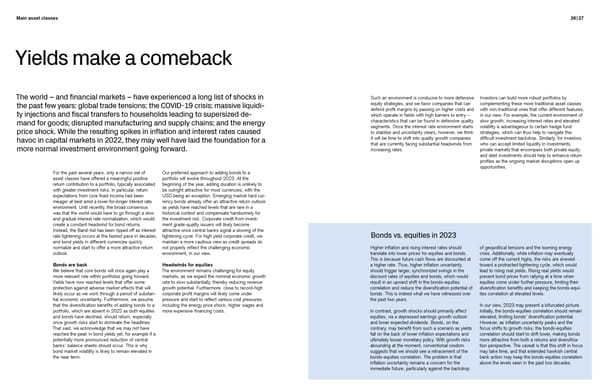Main asset classes 26 | 27 Yields make a comeback The world – and financial markets – have experienced a long list of shocks in Such an environment is conducive to more defensive Investors can build more robust portfolios by the past few years: global trade tensions; the COVID-19 crisis; massive liquidi- equity strategies, and we favor companies that can complementing these more traditional asset classes defend profit margins by passing on higher costs and with non-traditional ones that offer different features, ty injections and fiscal transfers to households leading to supersized de- which operate in fields with high barriers to entry – in our view. For example, the current environment of mand for goods; disrupted manufacturing and supply chains; and the energy characteristics that can be found in defensive quality slow growth, increasing interest rates and elevated segments. Once the interest rate environment starts volatility is advantageous to certain hedge fund price shock. While the resulting spikes in inflation and interest rates caused to stabilize and uncertainty clears, however, we think strategies, which can thus help to navigate this havoc in capital markets in 2022, they may well have laid the foundation for a it will be time to shift into quality growth companies difficult investment backdrop. Similarly, for investors that are currently facing substantial headwinds from who can accept limited liquidity in investments, more normal investment environment going forward. increasing rates. private markets that encompass both private equity and debt investments should help to enhance return profiles as the ongoing market disruptions open up opportunities. For the past several years, only a narrow set of Our preferred approach to adding bonds to a asset classes have offered a meaningful positive portfolio will evolve throughout 2023. At the return contribution to a portfolio, typically associated beginning of the year, adding duration is unlikely to with greater investment risks. In particular, return be outright attractive for most currencies, with the expectations from core fixed income had been USD being an exception. Emerging market hard cur- meager at best amid a lower-for-longer interest rate rency bonds already offer an attractive return outlook environment. Until recently, the broad consensus as yields have reached levels that are rare in a was that the world would have to go through a slow historical context and compensate handsomely for and gradual interest rate normalization, which would the investment risk. Corporate credit from invest- create a constant headwind for bond returns. ment grade-quality issuers will likely become Instead, the Band-Aid has been ripped off as interest attractive once central banks signal a slowing of the rate tightening occurs at the fastest pace in decades, tightening cycle. For high yield corporate credit, we Bonds vs. equities in 2023 and bond yields in different currencies quickly maintain a more cautious view as credit spreads do normalize and start to offer a more attractive return not properly reflect the challenging economic Higher inflation and rising interest rates should of geopolitical tensions and the looming energy outlook. environment, in our view. translate into lower prices for equities and bonds. crisis. Additionally, while inflation may eventually This is because future cash flows are discounted at come off the current highs, the risks are skewed Bonds are back Headwinds for equities a higher rate. Thus, higher inflation uncertainty toward a protracted tightening cycle, which would We believe that core bonds will once again play a The environment remains challenging for equity should trigger larger, synchronized swings in the lead to rising real yields. Rising real yields would more relevant role within portfolios going forward. markets, as we expect the nominal economic growth discount rates of equities and bonds, which would prevent bond prices from rallying at a time when Yields have now reached levels that offer some rate to slow substantially, thereby reducing revenue result in an upward shift in the bonds-equities equities come under further pressure, limiting their protection against adverse market effects that will growth potential. Furthermore, close to record-high correlation and reduce the diversification potential of diversification benefits and keeping the bonds-equi- likely occur as we work through a period of substan- corporate profit margins will likely come under bonds. This is indeed what we have witnessed over ties correlation at elevated levels. tial economic uncertainty. Furthermore, we assume pressure and start to reflect various cost pressures, the past two years. that the diversification benefits of adding bonds to a including the energy price shock, higher wages and In our view, 2023 may present a bifurcated picture. portfolio, which are absent in 2022 as both equities more expensive financing costs. In contrast, growth shocks should primarily affect Initially, the bonds-equities correlation should remain and bonds have declined, should return, especially equities, via a depressed earnings growth outlook elevated, limiting bonds’ diversification potential. once growth risks start to dominate the headlines. and lower expected dividends. Bonds, on the However, as inflation uncertainty peaks and the That said, we acknowledge that we may not have contrary, may benefit from such a scenario as yields focus shifts to growth risks, the bonds-equities reached the peak in bond yields yet, for example if a fall on the back of lower inflation expectations and correlation should start to drift lower, making bonds potentially more pronounced reduction of central ultimately looser monetary policy. With growth risks more attractive from both a returns and diversifica- banks’ balance sheets should occur. This is why abounding at the moment, conventional wisdom tion perspective. The caveat is that this shift in focus bond market volatility is likely to remain elevated in suggests that we should see a retracement of the may take time, and that extended hawkish central the near term. bonds-equities correlation. The problem is that bank action may keep the bonds-equities correlation inflation uncertainty remains a concern for the above the levels seen in the past two decades. immediate future, particularly against the backdrop
 Credit Suisse Investment Outlook 2023 Page 13 Page 15
Credit Suisse Investment Outlook 2023 Page 13 Page 15